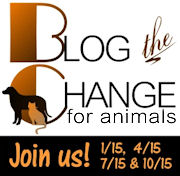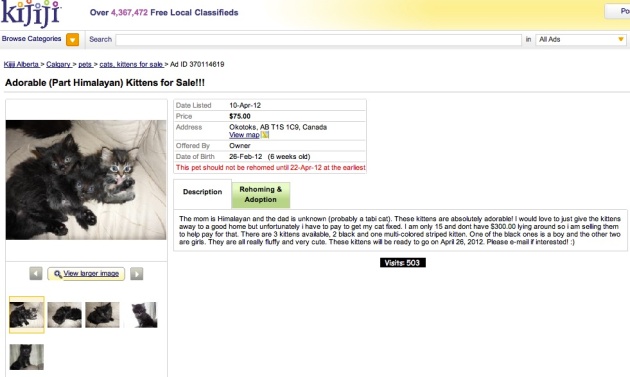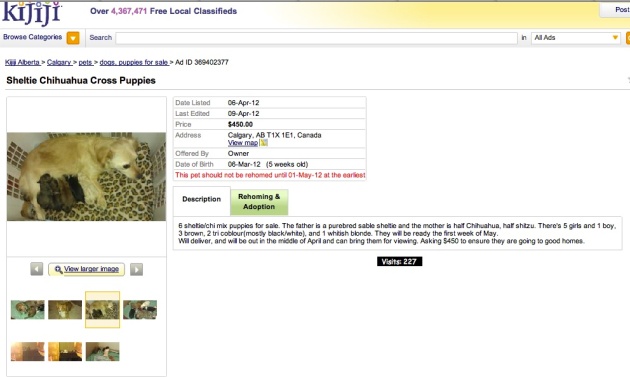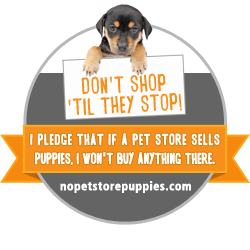One Ban Down, One To Go
July 16, 2012 3 Comments
Today was a good day for Calgary – and I don’t just mean the end to 10 days of western-themed debauchery.
As I’ve written here previously, I support a ban on shark fin for Calgary, and today our City Council voted 13-2 to ban the possession and sale of shark fin in Calgary! City Council will even lobby for a federal ban!
It might seem a little bit odd to ban shark fins in land-locked Calgary, but cutting of the demand of this product in the few places that sells it not only chips away at a larger problem, but sends a large public message.
Sounds, familiar, doesn’t it?
While obviously my personal focus has been advocating the pet sale ban, I’ve also been following the shark fin ban campaign and progress.
And even though I may be a little envious that they seem to have mobilized after us and reached their goal before us, I’m of course thrilled the ban passed.
Because it really should help pave the way for ASLC and the pet sale ban.
To illustrate, I’ve done a little comparison of the two campaigns:
| Shark Fin Soup | Retail Pet Sales | |
| Does the practice cause harm to animals? | Yes – the practice of finning is horrendous and decimates populations of sharks. Look it up if you don’t believe me. | Yes – High volume commercial breeders (aka “puppy mills” and “kitten factories”) are notorious for animal abuse and neglect, and the connection between these establishments and pet stores has been proven time and time again (look it up if you don’t believe me). The onus is on local pet stores to meet the demands of informed consumerism and be transparent about their pet sources, and they have not done so – what is one left to think? Not to mention, perpetuating the notion that animals are disposable commodities is also harmful to them. |
| Does this practice harm people? | Yes, indirectly – decimating the shark population will come back to bite us (pun intended). | Yes, the retail sale of commercially bred animals is bad for the customer – buying a mystery product that often costs more down the road. Forbes magazine reported ”So you’re buying a defective product at over-inflated prices, even if you don’t care about what happens to that puppy’s parents, it’s a bad, bad deal for the consumer.” |
| Will the ban affect our local animals? | Of course – though indirectly. Over-finning populations is a serious problem and the oceans are the world’s largest ecosystem. Even though Calgary is landlocked, ceasing demand for shark fin locally is a benefit. | Of course – and even more directly, since ending pet store sales can help increase adoptions of hundreds of local dogs and cats. And awareness of the broader issue helps to educate the public and put an end to local puppy mills and back yard breeders, too. |
| Will a ban affect consumers? | Yes – the ban means you won’t be able to go into a restaurant and order shark fin soup (though I’m given to understand there are imitation options available). | Yes – it means any dogs or cats you see in a pet store will be adoptable through a local rescue instead of for sale through the store. |
| Will the ban affect a lot of consumers? | Not really. Shark fin soup is often characterized as a traditional Chinese sign of status, but younger generations are moving away from it. | Not really. Not many pet stores still sell dogs and cats in Calgary, and you can see the younger generation having a greater focus on rescue and adoption. |
| Will the ban affect retailers? | Obviously, but not many – the ones that still have shark fin on the menu have until October to get rid of it. Many stores have discontinued the item on their own, though the ban ensures blanket compliance. | Obviously, but not many – while some remain, many pet stores in Calgary have already voluntarily switched to an adoption model for dogs and cats. A ban will ensure blanket compliance. |
| How will the ban affect the market? | Shark fin soup was a status symbol – it was not enjoyed for its unique culinary capabilities and the flavor of the soup actually comes from the other ingredients. As a food ingredient, it is pretty unnecessary except for the ability to show off the price tag (as bowls range from $50-200 in Calgary). That’s a high price for a pointless ingredient. If you really miss it, there are tonnes of other expensive food items you can buy to show off (caviar? white truffles?), or there are even imitation shark fin alternatives. | Like shark fin soup, puppies at pet stores have an unnecessary mark-up; you are paying purebred prices for a dog that cannot be purebred, since the Canadian Kennel Club prohibits its members from selling in retail environments. You are also playing health roulette, since you don’t know the genetic history of these animals nor do you get to see where the puppy was raised. The elimination of pet store sales will not affect anyone’s ability to get a dog or cat, since there are dozens of local rescues at capacity as well as reputable breeders to contact. |
| Is the suggestion of a ban met with cries of “nanny state” outrage and “social engineering”? | Yep. | You betcha. |
| Do critics say “why is city council wasting their time on this when I’m stuck in traffic every day?” | Heard it. You know, there are complete departments dedicated to those problems, too. | Yawn – what they said; what else you got? |
| Is Calgary the first place to ban this? | Not even close! Toronto is one example of another Canadian city with a shark fin ban. The state of California has also banned it, as well as China. | Not even close! Toronto also has a retail pet sale ban, as does Mississauga and Richmond, BC. Dozens of American cities have also instated them. |
| How did these things pass in Toronto? | Toronto city council voted 38-4 in favour of the ban. | Toronto city council voted the retail pet sale ban in unanimously. |
| What does the Director of Animal and Bylaw Services, Bill Bruce, say about this? | In favour. “I think [the bylaw itself] is probably a stronger message than the enforcement of it.” (As told to the Calgary Herald, July 16, 2012. | In favour. “You’re talking about a life here — you need to have more consideration to that than you would to buying a pair of shoes,” he explained. “The retail sale of cats and dogs is probably not in the best interest of the animal, because it’s an emotional buy.” (As told to Metro News, June 16, 2012) |
| What does Alderman John Mar (Ward 8) say about this? | After voting in favour of the ban, “He quipped that he and sharks have an agreement: ‘I don’t eat you and you don’t eat me’.” (As told to the Calgary Herald for a July 16, 2012 article.) | After indicating he would not vote for this ban, “Why on earth would we? That’s going a bit far.” (As told to the Calgary Herald for a June 30, 2012 article.) |
| What does the Calgary Herald editorial board seem to say about this? | For. See editorial ‘A Soup in Bad Taste’, July 12, 2012. | Against. See Herald blog ‘Banning sale of dogs and cats in pet stores and arf-ful idea’, dated June 27, 2012 and the editorial ‘Puppy Love’ of June 29, 2012. |
| What is the purpose of the ban? | 1. To stop an unnecessary practice that is harmful to animals and to which the ceasing of will not negatively affect Calgarians.2. To bring education and awareness to the public about a larger problem. | 1. To stop an unnecessary practice that is harmful to animals and to which the ceasing of will not negatively affect Calgarians.2. To bring education and awareness to the public about a larger problem. |
| Is there high-profile support for this cause? | Have you ever seen Sharkwater? If not, watch it! | Well-known dog advocates from Victoria Stilwell to Cesar Millan stress the importance of adopting pets and avoiding pet store sales. |
| Is there local support for this cause? | Yes!
Shark Fin Free Calgary has: – over 8200 petition signatures – Alderman Brian Pincott collected over 20 letters from Chinese Calgarians in support. – over 500 supporters on Facebook – over 250 supporters on Twitter |
Yes!
Actions Speak Louder (Calgary) has: – over 12,000 petition signatures – after Pet Expo this May mailed over 300 letters to City Council of Calgarians in support of the ban – over 1000 supporters on Facebook – over 250 supporters on Twitter – over 30 local businesses hosting the petition, both inside and outside of the pet community – over 35 local businesses and rescues that have pledged support of the cause |
| Sharks are awesome; does this ban help protect them? | Yes! Yay, sharks! |
No… but it does protect these little guys: |
Interesting comparison, if I do say so myself.
Both bans are designed to protect animals against the commercial exploitation and abuse of certain people – with added consumer awareness concerns about the pet store sales (a bowl of soup is for a meal, a puppy or kitten is for 15+ years).
And as far as the pet store ban goes, the public support seems greater and more widespread. Not to mention the local and immediate advantages to Calgary’s rescue organizations, pet owners, and pets is clear.
But there remain some certain local critics with loud voices, who, oddly, favour the shark fin ban but not the pet sale one. I’d really be thrilled if someone could explain what makes one okay and the other not.
Jason Markusoff, Calgary Herald civic affairs writer, tweeted today that shark fin soup is “pricey, ethically murky, and soon to be illegal”.
And retail pet sales?
Pricey? Check.
Ethically murky? Double check.
Soon to be illegal? Fingers crossed for September.

















